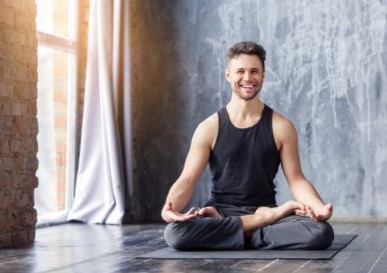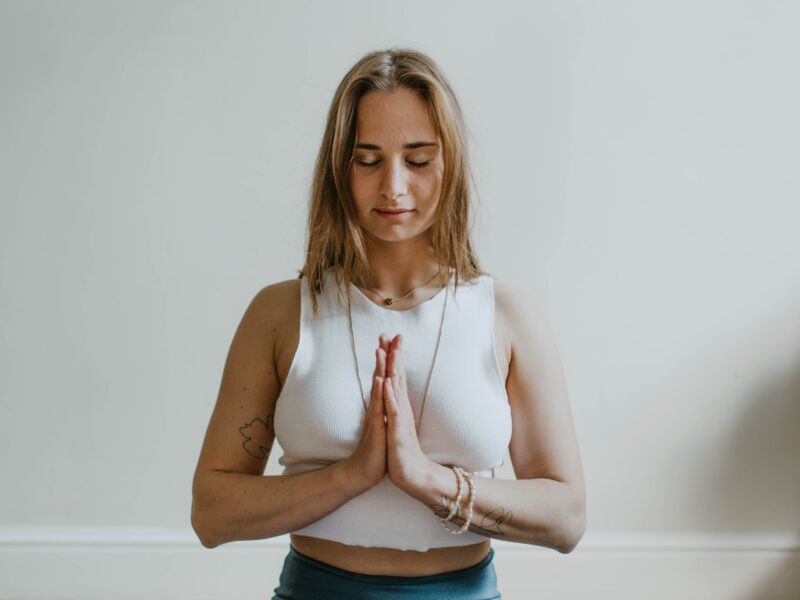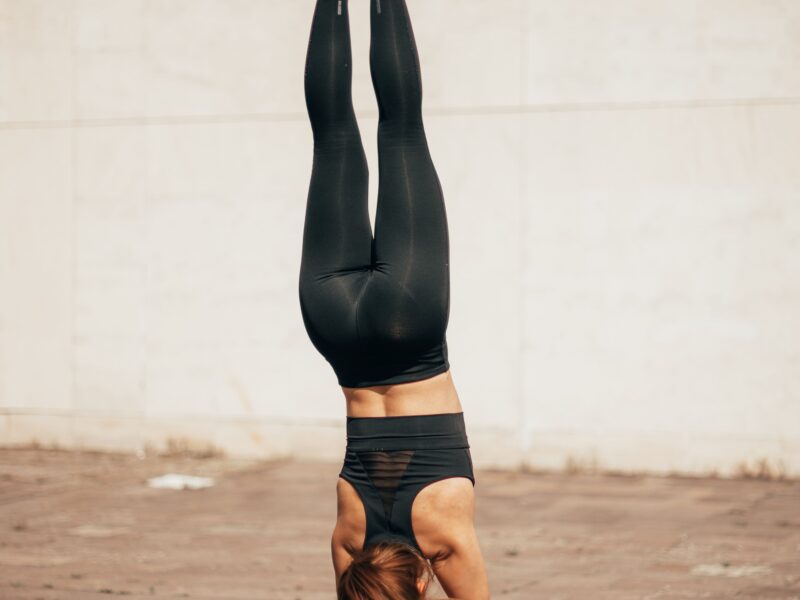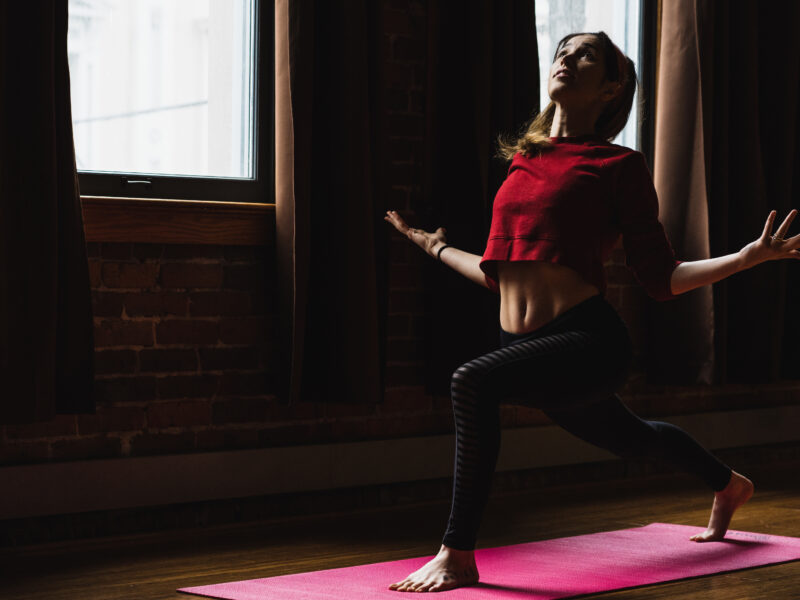In an ideal world, we’d always think and act from a place of wisdom and oneness. But in the real world, ingrained patterns and personality traits can get in the way. Enter the Enneagram, a personality assessment that can help you see what’s keeping you from realizing your most authentic, highest self. Here’s how to use it, along with your yoga practice, to change course.
Story by Elizabeth Marglin
Coral Brown, a yoga teacher and licensed mental-health counselor in Rhode Island, uses the word “co-dependent” to describe her previous romantic relationship, which lasted more than a decade. But at the time, she didn’t realize she was in such a pattern of over-giving that she was losing herself. While her yoga practice helped shine a light on this tendency, Brown says studying the Enneagram—a four-decadeold personality-assessment system—also revealed that it was time to move on from the relationship. “The Enneagram enabled me to really see my core patterns,” says Brown, “ultimately helping me meet my needs in a healthier, more conscious way than ever before.”
The name Enneagram stems from the Greek words ennea, a prefix for “nine,” and gramma, meaning “to draw.” The system’s icon is a ninepointed star, each point representing a distinct personality type. Most Enneagram experts agree we are all born with one dominant personality type (or number), which largely determines how we learn to adapt to our environment and the people in it. The Enneagram surfaced in the United States in the 197os, riding the tails of the human-potential movement (think therapy, encounter groups, and primal scream). Since then, therapists, spiritual teachers, coaches, and even businesses have used the Enneagram as a tool to stoke authenticity, expose core motivations, and ultimately reduce interpersonal conflict. How can a simple personality test do all this?
“There’s “There’s resistance to change within all of us, and the Enneagram describes what that resistance is about for each of us,” says Peter O’Hanrahan, a leading international Enneagram teacher and trainer. “As a result, this system gives you very clear information about what you need to work on.” To wit, when Brown learned more about her Enneagram number—a Two— she was better able to see her core pattern of giving to others to feel good about herself, and that realization gave her a choice: do something about her blind spots, or ignore them. She chose to act. “I left my partner, and I found more of my own identity in my yoga teaching,” says Brown. “I was more aligned with my truer purpose and nature.”
Susan Piver, author of the meditation primer Start Here Now and a meditation teacher who leads retreats on the Enneagram, says the kind of alignment Brown experienced is what yoga is about at its core. “The Enneagram will tell us what we cannot see about ourselves—our ways of being that stem from our most wounded selves, which create confusion as a result,” says Piver. And if you’re willing to look at these wounds, which are almost always rooted in unexamined pain, you can start to chart a new, more authentic course forward, she says. “At a certain point—especially if you’re on a spiritual path—you have to do this,” Piver says. Read on to find out how.
Who am I ?

The work of the enneagram begins with figuring out your number, which essentially represents how you present yourself to others, where your attention goes when you quiet down, and what triggers your behaviors. Piver, for example, is a Four, which means her chief issue is envy. “Before I knew I was a Four, I used to think that what I longed for would make me happy,” she says. “Now, I’m able to see the longing itself as a sign that I’m unsettled, unhappy, or hurt, and that I can turn my attention within instead of looking for something outside. This helps me notice when I need to take better care of myself.”
In addition to revealing negative patterns and deep wounds, the Enneagram also highlights your greatest strengths. For example, when Piver’s envy is brought into balance, it becomes the more evolved version of itself: equanimity. “Envy and equanimity are on a continuum,” she says. And these continuum’s exist for all of the numbers, which means that regularly trying to find balance between your strengths and blind spots is the key to living a more aligned, authentic life.
Even better, all of this self reflection comes with improved communication with other people. That’s why Piver calls the Enneagram an upaya, Sanskrit for “skillful means.” While she cautions against using the system to label someone, she says it can be a helpful tool to navigate communication blocks. For example: “My partner is a One, and Ones are focused on right and wrong,” says Piver. “I’m a Four, and Fours are focused on meaning. If we get into an argument, I want to talk and understand, but I can’t do that with him until I acknowledge what went wrong—that I see where the misstep happened. That is very useful to him because everything in him wants to get to the bottom of the right and wrong in order to fix it.” Once Piver’s partner’s needs have been addressed, they can then have the kind of conversation that also works for her.
Ultimately, the Enneagram can help us release the tight hold we have on our version of things. “It’s hard to understand a person’s makeup when you are only looking at it through your own lens,” says Piver. “But what if you were told, ‘Here are nine lenses—which one do you think this person is looking through?’ It gives you a way to let go of expectations so that a more genuine exchange can transpire. It generates compassion.”
Put the Enneagram into Practice
Yoga offers the perfect training ground to explore the nuances of your Enneagram type. When you know your number, you can start to use the Enneagram to let wash away what Patanjali called the “layers and imperfections concealing truth.” “It’s an incredible companion [to yoga] that covers territory yoga doesn’t address,” says Michael Cohen, founder of the Kirtan Leader Institute and a certified Enneagram practitioner. “Yoga talks in broad terms about how to transcend our limitations; the Enneagram gives incredible detail about what that means.” For example, each number has a corresponding somatic pattern.
“For Fives, Sixes, and Sevens, poses that bring energy to the lower body and the feet are very important because these types tend to leave their bodies by going up into their heads,” says O’Hanrahan. Once you know your type’s patterns, he says, you can customize your yoga practice to support the work you’re doing to escape your old grooves (or samskaras, in Sanskrit) and form new ones that serve you better. To that end, Brown has paired a pose with each Enneagram number to accentuate both the challenges and the possibilities for that number. Determine your type, then use your pose and mantra to continue your self-inquiry so that how you do asana reflects how you do you—with awakened clarity and compassion.
Discover your Number
The nine numbers, or personality types, of the Enneagram each have corresponding qualities. To determine your number, read about each one’s defining traits and key motivations here, and then see which number resonates most strongly for you. (Keep in mind that we have aspects of all nine types inside us, though we tend to have more of one type than the others.) With an open mind and an investigative spirit, simply notice what resonates most
1)THE REFORMER
DEFINING TRAITS: Principle, purpose, self-control, and perfectionism
KEY MOTIVATIONS: To be right; to strive for greater things
BASIC FEAR: Being corrupt, evil, defective
AT THEIR BEST: Ones are conscientious and ethical, with a strong sense of right and wrong. They are teachers and advocates for change, always striving to improve things.
AT THEIR WORST: Ones are afraid of making a mistake; they can slip into being critical and perfectionistic, and tend to struggle with resentment and impatience.
2)THE HELPER
DEFINING TRAITS: Generosity, people pleasing, and possessiveness
KEY MOTIVATIONS: To be loved, needed, and appreciated; to vindicate their claims about themselves
BASIC FEAR: Being unworthy of love
AT THEIR BEST: Twos are empathetic, giving, and driven to be close to others.
AT THEIR WORST: Twos can slip into doing things for others simply to feel needed. They typically have problems with possessiveness and acknowledging their own needs
3) THE ACHIEVER
DEFINING TRAITS: Adaptability, desire to excel, and image- consciousness
KEY MOTIVATIONS: To distinguish themselves from others; to be admired; to impress others
BASIC FEAR: Being worthless
AT THEIR BEST: Threes are self-accepting, authentic, and role models who inspire.
AT THEIR WORST: Threes can be overly concerned with their image and what others think of them; they typically have problems with workaholism and competitiveness.
4)THE INDIVIDUALIST
DEFINING TRAITS: Expressiveness, drama, selfabsorption
KEY MOTIVATIONS: To create and surround themselves with beauty, and to take care of emotional needs before attending to anything else
BASIC FEAR: Having no identity
AT THEIR BEST: Fours are highly creative, self-aware, sensitive, and reserved.
AT THEIR WORST: Fours can be moody and self-conscious. They typically have problems with melancholy, self-pity, and self-indulgence.
5) THE INVESTIGATOR
DEFINING TRAITS: Perceptiveness, innovation, and isolation
KEY MOTIVATIONS: To possess knowledge; to have everything figured out as a way of defending against threats from their surroundings
BASIC FEAR: Being helpless or incapable
AT THEIR BEST: Fives are visionary pioneers, often ahead of their time, and able to see the world in an entirely new way.
AT THEIR WORST: Fives can become detached. They typically have problems with eccentricity, nihilism, and isolation.
6) THE LOYALIST
DEFINING TRAITS:Responsibility, anxiety, and suspicion
KEY MOTIVATIONS: To feel supported by others, to test the attitudes of others toward them
BASIC FEAR: Lack of security or guidance
AT THEIR BEST: Sixes tend to be stable, self-reliant, and trustworthy. They foresee problems and foster cooperation.
AT THEIR WORST: Sixes can be indecisive, reactive, and rebellious. They can also become defensive and evasive, and deal with self-doubt and suspicion of others.
7)THE ENTHUSIAST
DEFINING TRAITS: Spontaneity, versatility, and scatteredness
KEY MOTIVATIONS: To maintain their freedom and happiness; to avoid missing out on worthwhile experiences
BASIC FEAR: Being deprived and in pain
AT THEIR BEST: Sevens are extroverted and practical. They focus their talents on becoming joyous and satisfied.
AT THEIR WORST: Sevens can become distracted and exhausted by staying on the go; they typically have problems with impatience and impulsivity.
8)THE CHALLENGER
DEFINING TRAITS: Decisiveness, self-confidence, willfulness
KEY MOTIVATIONS: To be self reliant and important in the world
BASIC FEAR: Being controlled by others
AT THEIR BEST: Eights are self-mastering, and use their strength to improve others’ lives. They are self-confident and decisive.
AT THEIR WORST: Eights can be egocentric and domineering. At times, they feel they must control the people around them, sometimes becoming confrontational. They can have problems with their temper and showing vulnerability.
9) THE PEACEMAKER
DEFINING TRAITS: Receptivity, reassuringness, complacency
KEY MOTIVATIONS: To create harmony; to preserve things as they are
BASIC FEAR: Loss and separation
AT THEIR BEST: Nines are able to bring people together and heal conflicts. They are accepting, trusting, and stable; they are usually creative, optimistic, and supportive.
AT THEIR WORST: Nines can be too willing to go along with others to keep the peace. They want everything to go smoothly, and so can also be complacent. They may have problems with inertia and stubbornness.
Pose by Number
Your yoga mat is the perfect place to explore and reconcile the core dilemma your Enneagram number has revealed. Each of these poses closely corresponds with each type’s physical manifestation of its inner predicament, says Brown. After warming up, practice the asana and repeat the mantra that matches your type. Experiment with all nine poses to become more discerning in all your relationships, from the ones you have with those around you to the one you have with yourself.
The Reformer

Practice Dhanurasana (Bow Pose)
MANTRA
I can lighten up, loosen my grip on perfection, and find pleasure in things just as they are.
Ones tend to repress their instincts and prefer to filter the world through their intelligence. Bow Pose provides a structured container for Ones to reengage with their more primal instincts, as well as soften around their limitations, as the posture puts pressure on the belly and stimulates the enteric nervous system (a.k.a. the “belly brain”).
HOW TO
Lying face-down on your mat, bend your knees and reach back to clasp the outside of your ankles. (If that’s not possible, clasp your feet or use a strap.) Rest your forehead on the earth and take a deep, mindful breath. As you exhale, engage your core and simultaneously press your pubic bone into the earth while lifting your heels and reaching your legs strongly back and up. Combine these actions with activating the muscles in your upper back while relaxing your face and jaw muscles. Hold for 3 rounds of breath. Repeat 3 times, then rest in Balasana (Child’s Pose) or a simple seated twist.
The Helper

Practice Paschimottanasana (Seated Forward Bend)
MANTRA
I can have my own needs and still be loved. Seated forward folds are grounding and insular, providing an opportunity to attune to your own wisdom. The symbolic gesture of bowing the heart forward offers Twos the visceral experience of self-reverence.
HOW TO
From a seated position, extend your legs and scoot your sitting bones back. On an inhale, elongate your spine and lift your chest like you were in Bhujangasana (Cobra Pose). As you exhale, fold forward, leading with your heart. Stay for several rounds of breath.
The Achiever
 Practice Sasangasana (Rabbit Pose)
Practice Sasangasana (Rabbit Pose)
MANTRA
I value deep heart contact. In this pose, the crown chakra roots to the earth in a way that grounds Threes, whose dilemma is often how to modulate their hard-driving energy. This neutralizing, simple posture stimulates connection to the head (consciousness) and the wisdom body (intuition), and deflects the Threes’ innate tendency to compete.
HOW TO
Start in Child’s Pose with your knees hip-distance apart, and rest your forehead on the mat. From here, place your hands under your shoulders and curl your toes under. On an inhale, hug your elbows inward and press into your hands as you lift your hips away from your heels. On an exhale, round your upper back to shift the weight from your forehead to your hairline and finally the crown of your head. Continue to press into your hands to distribute the weight and avoid putting too much pressure on your neck. If you feel comfortable here, bring your hands behind you to hold your ankles, heels, or toes. Stay in the posture for 3 rounds of breath.
The Individualist

Practice Virabhadrasana III (Warrior Pose III)
MANTRA
I am free of my old story. I stand my ground and speak my truth. This challenging balance pose moves energy away from the center and out into the limbs and crown, stimulating proprioception—awareness of one’s body in space. As they extend in all directions and gaze down in this pose, Fours learn to calibrate their internal compass and let go of comparison.
HOW TO
Come to High Crescent and place your hands on your hips. Take a centering breath; on the exhale, lengthen your spine as you lean your upper body forward. Begin to shorten your stance by walking your back foot in until you feel steady enough to lift your back leg. Without compromising the level structure of your hips, continue to lift your back leg until you reach your movement threshold or your leg is parallel to the earth. As you gaze down or directly in front of you, relax your face and jaw while simultaneously extending your spine and arms overhead; you can also keep your hands on or near your hips. Hold the pose for 3 rounds of breath, and then repeat on the second side
The Investigator

Practice Ustrasana (Camel Pose)
MANTRA
I can engage with the world without holding back. This backbend encourages opening the heart—critical for Fives, whose chief defense is disengagement and who tend to be happiest alone. Backbends help Fives connect to their feelings and receive energy freely. Camel Pose lets the practitioner modulate the intensity of the backbend, giving Fives an opportunity to explore trust and openness in small, safe increments.
HOW TO
Kneel on your shins with your toes curled under and your hips over your knees; place your hands in Anjali Mudra (Salutation Seal, or prayer position), as if you were in Tadasana (Mountain Pose). Inhale and feel the safety and stability of the posture. Exhale and bring your hands to support you at your lower back. Wrap your elbows in toward one another. With every inhale, elongate your spine so that you grow taller and broader; with every exhale, soften your shoulders, neck, and jaw as you lift your gaze and maybe your chin. If you feel stable here, slide your hands to rest on your heels. Stay for 3 rounds of breath.
The Loyalist

Practice Matsyasana (Fish Pose)
MANTRA
I have faith in myself and do not need to fear the unknown. This backbend exposes the throat and chest, requires trust and commitment, and cultivates an expansive awareness—all appropriate actions for Sixes, whose nemesis is doubt. Sixes can learn to have faith and take action despite the uncertainty this asana often invokes.
HOW TO
From a reclining position, prop yourself up on your elbows. Lengthen your legs and point your toes. Similar to Camel, hug your elbows in while lifting your gaze and chin. On an inhale, broaden your collarbones and squeeze your shoulder blades together; exhale and try to release your head back while relaxing your throat, face, and jaw. Breathe evenly here for 3 rounds, continuing to lift your heart and broaden your chest.
The Enthusiast

Practice Malasana (Garland Pose)
MANTRA
I have everything I need here and now. Malasana concentrates energy downward, grounding one’s awareness and literally bringing Sevens back to earth and challenging their fear that stability leads to stagnation.
HOW TO
Stand with your feet at least mat distance apart, with your toes turned out slightly. On an exhale, lower your hips to a squatting position, and track your knees over your toes. Bring your hands together in Anjali Mudra while pressing your upper arms against your inner thighs. With each inhale, rise from your roots by lengthening your spine and pressing your arms to your legs. With each exhale, feel the natural state of contraction by bowing your head, releasing the pressure of your arms, and slightly rounding your spine. Stay here as long as you feel comfortable, letting each round of breath ground and center you.
The Challenger

Practice Anjaneyasana (Low Lunge)
MANTRA
I’m willing to be vulnerable. This pose works the psoas—a muscle directly linked to our fight-or-flight response—which helps Eights learn the humility that comes from allowing oneself to be vulnerable.
HOW TO
From Down Dog, exhale and step your right foot to your right hand, aligning your right knee over your heel. Lower your left knee to the floor and turn the top of your left foot downward. On an inhale, use the rooting action of your front foot to lift your torso upright. Inhale and extend your arms overhead; exhale and feel the grounding weight of your hips. Scissor your legs toward the midline to support the lift. Stay here for 3 rounds of breath, and then release and repeat on the second side.
The Peacemaker

Practice Natarajasana (Lord of the Dance Pose)
MANTRA
I can dance to my own drumbeat and still be part of my tribe. The dual actions of this pose—the extending out and the rooting-down—require Nines to find their core while being pulled in different directions.
HOW TO
Stand at the top of the mat and shift your weight to your left side. Place your hands at your hips and draw your right knee toward
your navel. Feel your core engage as you lean forward and extend your right leg behind you, then catch your right ankle with your right hand. Slightly bend your standing left leg, simultaneously lifting your left sitting bone and extending strongly through your right leg. At the same time, reach your left arm forward, parallel to the floor. Inhale and exhale as you maintain a balance of stability (level hips and shoulders) with mobility (back bending and right-leg extension). Stay for 3 rounds of breath; repeat on the other side.
Photography by Jeff Nelson
This article was first published in the print edition of Yoga Journal Singapore which is now Yogahood Online.






